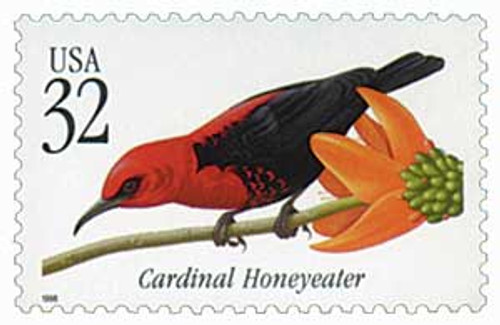
1998 32c Crested Honeycreeper Tropical Bird
# 3224 - 1998 32c Crested Honeycreeper Tropical Bird
$1.00 - $3.20
U.S. #3222
1998 32¢ Crested Honeycreeper
Tropical Birds
1998 32¢ Crested Honeycreeper
Tropical Birds
Issue Date: July 29, 1998
City: Ponce, Puerto Rico
Quantity: 17,500,000
Printed By: Banknote Corporation of America
Printing Method: Lithographed
Perforations: 11.2
Color: Multicolored
City: Ponce, Puerto Rico
Quantity: 17,500,000
Printed By: Banknote Corporation of America
Printing Method: Lithographed
Perforations: 11.2
Color: Multicolored
This issue is part of a four-stamp se-tenant featuring tropical birds that are native to the islands belonging to the United States. The Antillean Euphonia resides in the thick mountain forests of Puerto Rico. The Green-throated Carib is also found in Puerto Rico, but along the northeast coast. The Crested Honeycreeper is an endangered species from the rain forests of Maui, and the Cardinal Honeyeater lives on the South Pacific island of Samoa.
The endangered crested honeycreeper is found only in the upper rainforests of East Maui. Once widespread throughout the Hawaiian islands, the honeycreeper is now confined to the most remote areas. Called “Akohekohe” in Hawaiian, the bird displays some of the most unusual colors of any of the native honeycreepers. It is one of about 22 species believed to have evolved from a common ancestral species that arrived in Hawaii millions of years ago.
All honeycreepers mate between December and July, and the young hatch from their eggs after a three-week incubation period. One bird can lay two or three eggs in cup-shaped nests they build on tree branches. Both parents are responsible for feeding the young. Honeycreepers are divided into subgroups. Birds of one group feed mainly on nectar, while those belonging to the other group eat seeds.
The Hawaiian honeycreeper is being seriously threatened by natural predators as well as man. Tree rats are its primary enemy. But man’s destruction of the birds’ habitats is a more significant threat. Because of inaccessibility to remote areas where the birds live, it is difficult to determine the exact decrease in the number of honeycreepers.
U.S. #3222
1998 32¢ Crested Honeycreeper
Tropical Birds
1998 32¢ Crested Honeycreeper
Tropical Birds
Issue Date: July 29, 1998
City: Ponce, Puerto Rico
Quantity: 17,500,000
Printed By: Banknote Corporation of America
Printing Method: Lithographed
Perforations: 11.2
Color: Multicolored
City: Ponce, Puerto Rico
Quantity: 17,500,000
Printed By: Banknote Corporation of America
Printing Method: Lithographed
Perforations: 11.2
Color: Multicolored
This issue is part of a four-stamp se-tenant featuring tropical birds that are native to the islands belonging to the United States. The Antillean Euphonia resides in the thick mountain forests of Puerto Rico. The Green-throated Carib is also found in Puerto Rico, but along the northeast coast. The Crested Honeycreeper is an endangered species from the rain forests of Maui, and the Cardinal Honeyeater lives on the South Pacific island of Samoa.
The endangered crested honeycreeper is found only in the upper rainforests of East Maui. Once widespread throughout the Hawaiian islands, the honeycreeper is now confined to the most remote areas. Called “Akohekohe” in Hawaiian, the bird displays some of the most unusual colors of any of the native honeycreepers. It is one of about 22 species believed to have evolved from a common ancestral species that arrived in Hawaii millions of years ago.
All honeycreepers mate between December and July, and the young hatch from their eggs after a three-week incubation period. One bird can lay two or three eggs in cup-shaped nests they build on tree branches. Both parents are responsible for feeding the young. Honeycreepers are divided into subgroups. Birds of one group feed mainly on nectar, while those belonging to the other group eat seeds.
The Hawaiian honeycreeper is being seriously threatened by natural predators as well as man. Tree rats are its primary enemy. But man’s destruction of the birds’ habitats is a more significant threat. Because of inaccessibility to remote areas where the birds live, it is difficult to determine the exact decrease in the number of honeycreepers.












